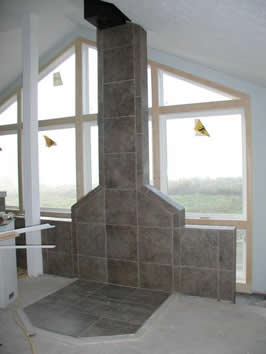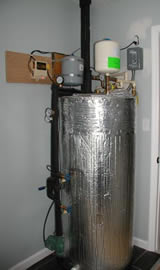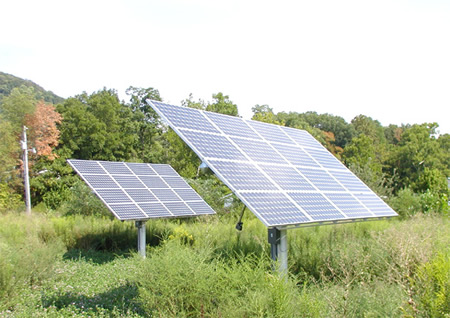|
"Sunshine came softly through my window today" ... and powered my home! This article won't be able to cover every trick in the book when it comes to home solar energy, but we'll cover basic systems and designs, and help you understand "solar strategies"—that is, how to most cost-effectively make your home a solar-energy home.
The term "passive solar" can mean a lot of things, but to keep things relatively simple, we're going to discuss the main form of passive solar energy—using (or rejecting) direct sunlight to reduce the amount of electricity or fuel you need to use to heat or cool your home. During the winter, the sun streaming in your windows will help warm the house and lower your heating bills; during the summer, your carefully designed roof overhangs and other features will help reject the sun and reduce your A/C bills.
New Homes and Major Re-Do's
 If you have the opportunity to design and build a new home, including passive solar is a no-brainer. It costs very little extra to design for passive solar, but the energy savings over the lifetime of the house will be enormous. Similarly, if you can swing a major rehab of your existing home, paying attention to the dictates of passive solar design will be of great benefit. Here are some issues to consider.
If you have the opportunity to design and build a new home, including passive solar is a no-brainer. It costs very little extra to design for passive solar, but the energy savings over the lifetime of the house will be enormous. Similarly, if you can swing a major rehab of your existing home, paying attention to the dictates of passive solar design will be of great benefit. Here are some issues to consider.
- You want lots of windows on the south side of the house, with fewer windows on the other sides. The reason is that the sun arcs across the southern sky in the winter (in the northern hemisphere), and its angle is just right for the sunlight to come through all of those south-facing windows.
- You want lots of thermal mass—block, brick, and tile—on the south side of the house (inside the house), with much of it positioned so it can be struck directly by the sun in the wintertime. The thermal mass absorbs and stores the heat energy during the day and then radiates it back into the living space as night falls and the interior temperature begins to cool. Dark tile that has a rough surface will usually absorb more of the sun's energy than light-colored tiles or those with shiny, smooth surfaces. The amount of thermal mass one needs varies somewhat based on climate and application, but generally, the exposed area of thermal mass should be about six times the area of glass that receives direct sunlight.
- While sunlight coming through windows is a boon during the winter, it's a big negative during the cooling season. For this reason, you want to make sure your roof on the south and west faces have the proper amount of overhang. (See: Overhang Calculator Tool) The combination of the overhang and the sun's higher summer elevation should work to block most of the direct sunlight on the windows, but you may find that removable awnings or well positioned deciduous trees can also help.
Add-On Passive Solar Kits
For an existing home, installing a "passive solar add-on" may be a better option than a complete remodeling. The normal approach is a "trombe wall" design, with a glass face that lets sunlight in, a black block wall to store the heat, and vents to allow the warmed air to be channeled into the house (and vent covers that can be closed for the summer!). Some people have added passive solar to their homes by building a greenhouse addition and allowing it to share the air with the house during the winter. This does add warm air to the house, but it may also add too much humidity. Whatever route you go, find a qualified installer (unless you're an around-the-house pro).
Windows and Shades
Whether you are building a new home or have an existing one, good windows are an important part of your solar-energy strategy. Look for "low-e" windows with a low U factor (which means the window resists transmitting heat) and a high solar heat gain coefficient (which means you get more boost from the sun during the winter). Not all window manufacturers make windows with this combination of characteristics, so do your homework and shop around. Finally, avoid low-E add-on coatings for existing windows.
Next, get good insulating window shades. Double-celled cellular shades work great and are attractive. Go for light colors so you still get plenty of daylighting with the shades down. (Good daylighting helps reduce electricity costs for lamps and other lights.) During the winter, keep the shades up when the sun is shining on the windows and mostly down at other times. During the summer, in theory, you would want to keep the shades down all the time since they not only help reject sunlight but also improve the R value of the window. But doing that also cuts down on daylighting, so if you need to compromise, just keep the shades down at night and anytime the sun is shining on a window. If you're away during the day, you'll again have to figure out the best compromise based on the season and the weather forecast.
Solar hot water heaters look pretty much like regular hot water heaters, at least in terms of the water tank itself.
 There will be more pipes and gizmos on and around the tank, and up on a south-facing section of your roof there will be one or two panels to collect sunlight and transfer the heat energy to a solution that runs through pipes in the panel. The pipes carry the hot solution back to the water tank where a heat exchanger heats up the water in the tank.
There will be more pipes and gizmos on and around the tank, and up on a south-facing section of your roof there will be one or two panels to collect sunlight and transfer the heat energy to a solution that runs through pipes in the panel. The pipes carry the hot solution back to the water tank where a heat exchanger heats up the water in the tank.
In most systems, an auxiliary heating element is available to supplement the solar heating (when the sun isn't shining much or during times of abnormally heavy hot-water use). A timer should be used to control when the heating element is allowed to come on (so you don't use electricity to heat the water just before the sun would have done it anyway).
You can maximize your benefit from a solar hot water system by shifting your habits—things like doing hot- or warm-water laundry on sunny days and taking showers in the afternoon or evening. Generally, solar water heaters pay for themselves within four to eight years, and after that, it's pure savings.
A twist on the solar hot water route is radiant heating. Solar panels on the roof heat a fluid that runs through pipes under the floors. The heat rises from the floor to warm to rooms in the house. A high efficiency backup heater supplements the solar panels' energy input as necessary on cloudy days and at night.
Solar electric—also called photovoltaic (PV)—uses solar panels to convert photon energy to electrical energy, which is produced as direct current (DC). You can buy special DC appliance and fixtures and just use DC current in your home—and that is a more efficient way to use the juice generated by your solar panels—but normally you'll want an inverter to convert the output to alternating current (AC), which is what all "normal" household stuff runs on.
The solar panels can be mounted in fixed position on a south-facing roof or on a ground-mounted rack, or they can be installed on a tracking system that keeps the panels oriented to the sun at all times. Tracking systems usually make sense in terms of total kW output per dollar invested, but a good solar installer will help you determine whether this is true in your case.

This picture shows two solar arrays (5.4kw total) mounted on two-axis tracking systems. Adding tracking to a system is more costly than mounting the panels in a fixed position, but it gives the system about a 30% boost in overall output.
Remotely located homes—and homes owned by hard-core solar enthusiasts—may not tie into the electric grid at all, instead getting all of their electricity from their solar system (and possibly other systems like a back-up generator). But most solar PV systems installed today are grid-tied, which means you'll supplement the output of your solar panels with electricity from the grid. If your area has "net metering" and you sometimes generate more power than you use, you can send the excess back to the grid for credit or cash (depending on your power company's rules). Battery backups are another option many solar PV owners go for, and they're a must if you're off-grid.
Installing a variety of technologies and design solutions in an effort to take advantage of "free" energy from the sun makes the most sense when combined with serious energy efficiency efforts. A lot of conservation is common sense behavior—for instance, turning off lights and appliances when not in use and not keeping the freezer or refrigerator door open while you spend 3 minutes deciding what you want to eat. But there are improvements to your home that can take you even further in your quest for a smart-energy/solar-energy house.
There are many good articles on the web about reducing the energy requirements of your home, so we'll just tick off a few of the normal ideas:
- replace all of your light bulbs with compact fluorescents (except for rheostat-based lights, where you should make sure the rheostat is the more-efficient electronic type);
- buy energy-efficient appliances and electronics;
- improve wall and attic insulation; in the attic, use blown cellulose to insulate;
- seal cracks around windows;
- seal cracks around door frames and make sure doors have good sweeps and insulation strips;
- get an energy audit, which will help you figure out how to best address the previous three items (and more);
- get insulated exterior doors, high-performance windows, and insulating window shades (see passive solar section);
- get a light-colored metal roof to reject summer sun's heat (unless you live in the north, where heating is much more of a requirement than cooling);
- install a programmable thermostat to help you avoid over-cooling or over-heating your home.
The EnergyStar web site has a wealth of information on most of these subjects.
If you're building a new home, try to convince your builder to build the exterior walls out of 2x6s on 24" centers as opposed to 2x4s on 16" centers. The walls will be just as strong, with little extra cost for wood and labor, but the extra thickness of the walls will accommodate more insulation and increase the walls' R value.
If you're building a new house or are in the market to replace your aging HVAC unit, get a heat pump system with the highest advisable SEER rating for your area. Also consider a ground-connected (geothermal) heat pump if you live in a climate that sees hot summers and/or cold winters (which is when geothermal systems greatly outperform even the best "normal" heat pumps).
Many people start off with grand visions of going 100% solar. It can be done, but the more normal case is to optimize your house for the given amount you can spend. Here's our take on how much bang for the buck you get with each type of technology (10 = best).
| |
|
| |
Energy efficiency/conservation |
10 |
10 |
|
| |
Passive solar |
9 |
7 |
|
| |
Solar hot water |
8 |
8 |
|
| |
Solar PV |
4 |
4 |
|
Solar PV is very nice, but it's still the most expensive way to use the sun's energy. That doesn't mean you shouldn't do it; solar PV is often an important part of a smart strategy that creates a house that is efficient and resistant to disruptions of grid electricity.
|
Overall, though, every kilowatt hour you generate OR save with your solar technologies is a kilowatt hour you don't have to buy from the grid and a kilowatt hour's worth of power-plant pollution you won't add to the planet.
Finally, some solar systems will be eligible for federal or state tax credits/deductions. Tax breaks for conservation upgrades like windows and insulation may also be available. Check the
DSire web site
for more info.
|
|
MAD MAX BEYOND THE SOLAR DOME |
|
A b o u t t h e A u t h o r ...
The 1600-sqft house that serves as both as a home and as Grinning Planet office space exceeds the requirements for Energy Star's 5-star (best) rating. Features include passive solar design; ground-connected heat pump; whole-house fan as A/C alternative; solar hot water system; 5.4kW grid-tied solar PV system with battery backup; metal roof to reflect summer sun and fans to vent hot air from attics; high insulation strategy. House is designed for good day-lighting; all lights are compact fluorescents or use electronic rheostats; all appliances and fixtures are Energy Star-rated.
|
|
Tools for finding local solar installers:
-- Source Guides - Renewable Energy Installers by State
-- FindSolar.com
Know someone who might find this Home Solar Energy article helpful? Please forward it to them.
|
Books:
- See books related to
Home Solar Energy
Or search Amazon.com for ....
More articles and resources on....
Get Grinning Planet free via email
|
| |
GP ARTICLES RELATED TO
Home Solar Energy
|
| |
|
TRADING IN DINOSAUR POWER ON A BETTER MODEL
Peak Oil Solutions
— Real Energy Solutions for Declining Energy Supplies
JOULES WATT, BURNIE COLE & OTHER FICTIONAL ENERGY CHARACTERS
The Story on a New
Pollution-Free Energy Source
that is Also Cheap and Abundant
STOP WRITING MONTHLY CHECKS TO NOSFERATU
Vampire Power
— Wasted Standby Power in Home Electronics and Appliances
|
| |
|
|


